MARIANI’SVirtual
Gourmet
July
24,
2011
NEWSLETTER

Follow @VirtualGourmet
❖❖❖
This Week
Palm Beach, Part Two
by Edward Brivio and John Mariani
New York Corner: What's Not So New Under the NYC Sun
by John Mariani
Man About Town:
by Christopher Mariani
Wine: Great Burgundies Do Not Have to Cost a Fortune
by John Mariani
❖❖❖
Mariani's Quick Bytes
If you would like to be featured in Quick Bytes please visit our media page at www.JohnMarianiMedia.com
*Paid Advertisements*
| Australian Perigord Truffles AUSTRALIAN PERIGORD
TRUFFLES, The Trufferie in Manijump is unearthing some of the most
potent Perigord aroma that eclipses most of what is found in the
European winter. The Chefs Diamond Company www.thechefsdiomand.com
suppliers to this Countries most renowned Chefs, has just recently
started selling Fresh Truffles to the retail market, Private Chefs and
Foodies please visit our online store for what's sure to leave you
captivated... These Perigord Truffles are not to be misinterpreted, Yes
they are available fresh and YES they are The True Perigord Spore...
For more info visit the Farm Down Under www.wineandtruffle.com.
Chefs please call King Truff at 219-798-5662 or email
kingtruff@gmail.com
|
| City Harvest City Harvest, the world's
first food rescue organization which feeds over 300,000 hungry New
Yorkers each week, is announcing a brand new event: The Brooklyn Local.
On Saturday, September 17th, over 75 artisinal vendors will converge at
Brooklyn Park to showcase the best of Brooklyn food and to help City
Harvest feed more hungry New Yorkers. For more details visit www.CityHarvest.com
|
| The Last Flight of Jose Luis Balboa Set in Miami, Gonzalo Barr's
"The Last Flight of Jose Luis Balboa" vividly captures a city defined
by the blur of cultures. The L.A. Times Book Review wrote that the
"stories sparkle." And the Times Literary Supplement (London) called it
a "brilliant short story collection." "It is a great read for the
summer, even if you can't make it to South Beach." To purchase, visit Amazon.com
|
Place your Quick Byte Here |
by Edward Brivio
Photos by Robert Pirillo
And the Hottest New Spot in Town
by John Mariani
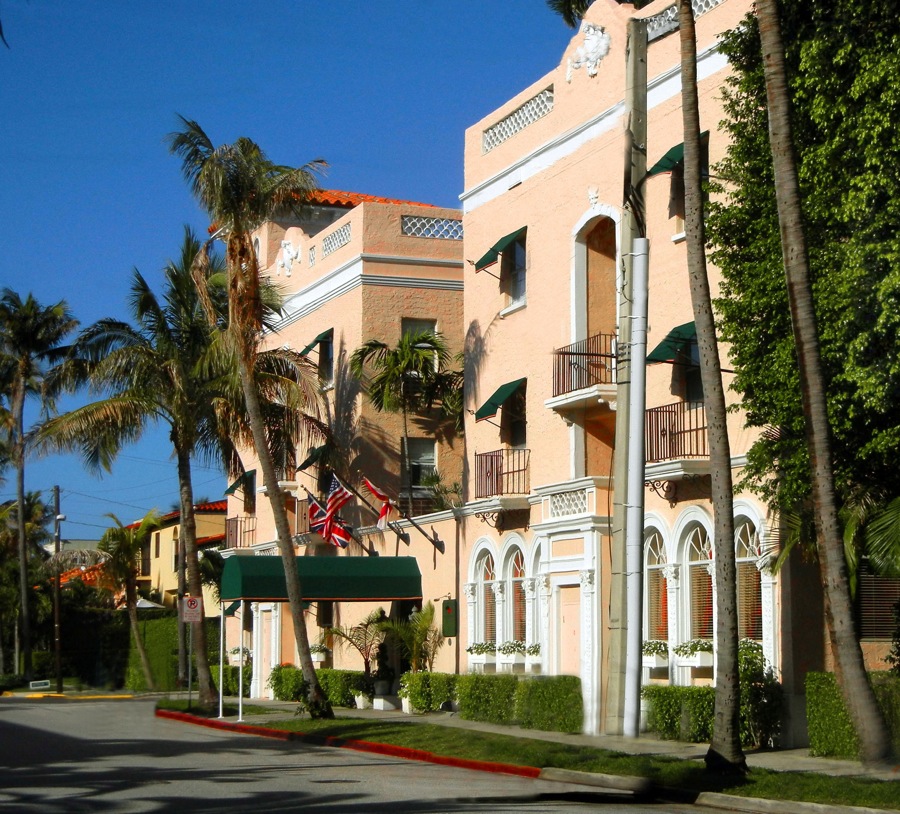 If
The
Breakers
is
a
tad
too
grand
for
your
taste
or
budget,
the Chesterfield
Hotel, built
in 1925,
is a change of pace, yet another excellent example of the
Mediterranean Revival style architecture
that provides Palm Beach with much of its visual appeal. Now owned by
the British, Red
Carnation hotel group, which recently finished a major renovation of
the
property, the Chesterfield brings a bit of merry old England to
Florida‘s
Gold
Coast, from its reception area awash in paisley chintz, and
paneled walls to the complementary glass of sherry offered at
check-in to our
room that appeared to come straight out of a posh English country-house
hotel,
complete
with wainscoting, and white walls covered with framed architectural
prints.
If
The
Breakers
is
a
tad
too
grand
for
your
taste
or
budget,
the Chesterfield
Hotel, built
in 1925,
is a change of pace, yet another excellent example of the
Mediterranean Revival style architecture
that provides Palm Beach with much of its visual appeal. Now owned by
the British, Red
Carnation hotel group, which recently finished a major renovation of
the
property, the Chesterfield brings a bit of merry old England to
Florida‘s
Gold
Coast, from its reception area awash in paisley chintz, and
paneled walls to the complementary glass of sherry offered at
check-in to our
room that appeared to come straight out of a posh English country-house
hotel,
complete
with wainscoting, and white walls covered with framed architectural
prints.
With a quite large and comfortable king-sized bed, and good-sized seating area with love seat and coffee table, and a workspace with desk, our mini-suite surrounded one in luxury, and had a window, providing light and air, overlooking the lovely pool area. The building may be a landmarked period piece, but everything about the room felt fresh, bright, and new, especially the marble-clad bathroom, complete with luxury toiletries and the best-looking bathrobes--red-and-white striped--I’ve yet to find in a hotel.
Only
two
blocks
from
Worth
Street
and
three
from
the
ocean,
with
its small courtyard
café, vivid
British-racing green marquée and deep awnings of crisp canvas
and a
lovely,
palm-fringed, heated pool, the Chesterfield is an oasis of tranquility
smack in
the middle of town. All too easy it was, then, to while away the
sunlight
hours
stretched out in the shade of a large market-umbrella, on one of the chaises-longues
surrounding the pool, lulled by the murmur of the water
falling from the
small, stone fountain at one end. An affable, eager staff see to it
that, even
poolside, no guests’ needs are overlooked. The hotel is also
pet-friendly. Indeed, as we checked in, the local Animal Rescue League
was 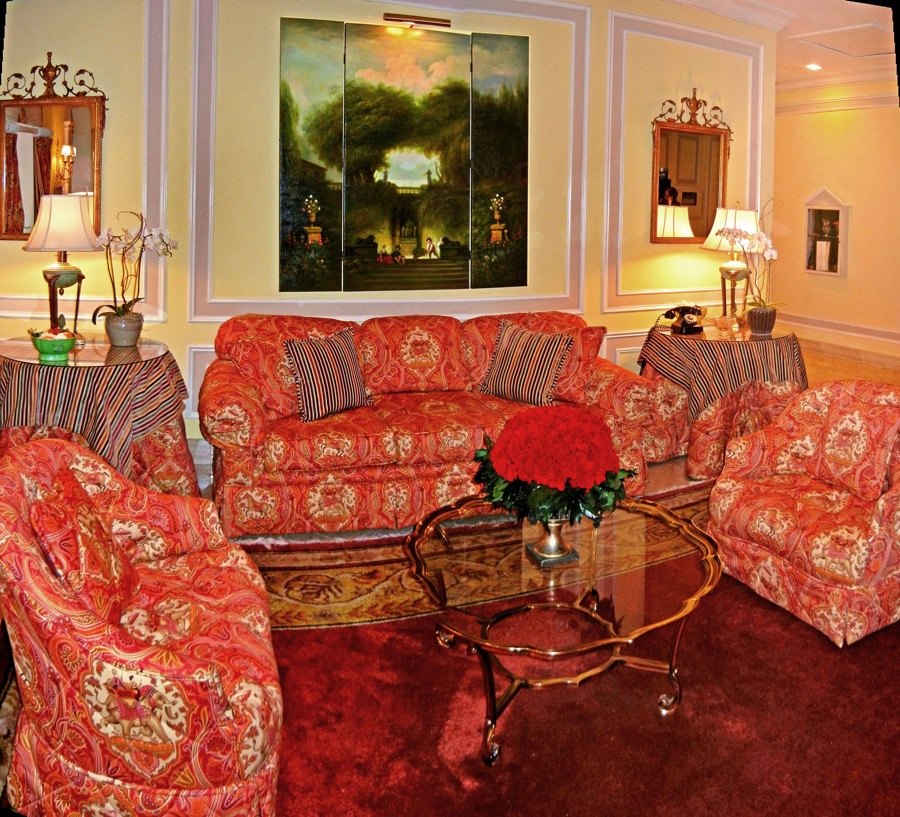 holding a benefit lunch in the dining room, and the lobby
was filled with
well-bred, well-mannered dogs with their owners.
holding a benefit lunch in the dining room, and the lobby
was filled with
well-bred, well-mannered dogs with their owners.
Its
supper
club/restaurant,
known
as
the
Leopard
Lounge (below), has
become
a
nightly
haunt,
for
locals
and
visitors
alike.
I
can’t
quite
pin down
from which decade came the inspiration for the vintage
décor, but this
quirky, slightly louche and theatrical look (and
rather good
live-music) is what makes the Lounge such a popular supper club.
Doubtless,
this out-of-the-past impression was deepened the night we were there by
the
large birthday party of at least 60 filling a good part of the dining
room.
Don’t
be
misled
by
the
heavy
swag
valances
of
deeply
ruched
and
tasseled
burgundy fabric on
all the
windows, the leopard-print carpet and fabrics featured throughout
the room
or the hand-painted ceiling of female nudes emerging from what looks
like
nothing so much as raspberry swirl ice cream. There was nothing stale
or offhand about the
dishes coming
out of the kitchen, all obviously prepared à la minute.
Executive
Chef
Gerard Coughlin and his équipé know their
business and take
pleasing their diners seriously. And you can dance between courses.
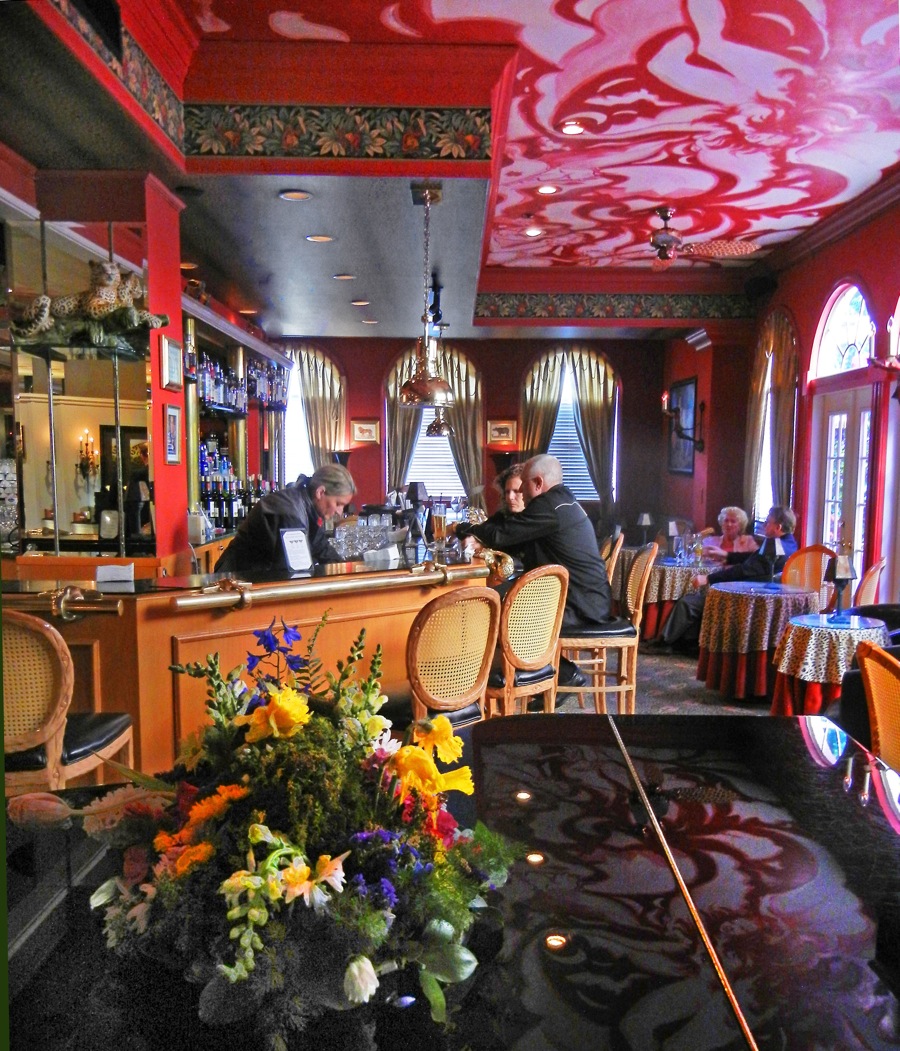 Oysters Rockefeller
and Maryland style lump crab cakes were superb, the oysters plump and
hot from
the oven, with a crusty, browned top, as were the pure crustacean
crabcakes, only held together long enough to be conveyable by fork
from plate
to mouth. A classic Caesar salad preceded the
entrees, and here again the kitchen could do no wrong. Gerard’s roast
duckling with an orange glaze and almond/fennel stuffing was just
about
perfect: well-roasted without being dry, deep mahogany in color,
with
crisp skin, hardly any fat, and delicious juicy flesh. And the enormous
grilled veal chop was as
good as it gets, and I couldn’t have wished for anything
better
alongside it than creamy mashed potatoes and a well-dressed, chopped
salad.
Oysters Rockefeller
and Maryland style lump crab cakes were superb, the oysters plump and
hot from
the oven, with a crusty, browned top, as were the pure crustacean
crabcakes, only held together long enough to be conveyable by fork
from plate
to mouth. A classic Caesar salad preceded the
entrees, and here again the kitchen could do no wrong. Gerard’s roast
duckling with an orange glaze and almond/fennel stuffing was just
about
perfect: well-roasted without being dry, deep mahogany in color,
with
crisp skin, hardly any fat, and delicious juicy flesh. And the enormous
grilled veal chop was as
good as it gets, and I couldn’t have wished for anything
better
alongside it than creamy mashed potatoes and a well-dressed, chopped
salad.
Somehow, we found room for desserts: Strawberry Eaton Mess, and English sticky toffee pudding with vanilla ice cream. Any dessert with both “sticky” and “toffee” in its name is for me, and why pass up fragrant strawberries and whipped cream?
The maître’d, after we’d given him a good idea of our preferences and price-point, suggested a 2008 Dutton Goldfield, Dutton Ranch, Russian River Valley, Pinot noir ($65). Not only just about perfect with what we were eating, but also a pinot noir more Burgundian than New World, medium-bodied, with lively, fresh fruit, a hint of spice, and the supple tannins and acidic structure to back it up.
Starters: $15 to $18, soups/salads: $7 to
$13, entrees: $17 to $38, desserts: $7 to $10.
Another
must
on
any
visit
to
Palm
Beach
is
Café
Boulud , a branch of restaurateur Daniel Boulud's NYC
original. For starters there’s its location, right
off one of the lush courtyards, in the glorious, beautifully restored
Brazilian
Court Hotel, another 1920‘s gem, straight out of the LA of a 40’s
Hollywood
movie, long neglected but recently brought back to glowing good
health. Then
there’s the dining room itself, a suite of long, low rooms, in serene
earth
tones, pictures on the walls to interest the eye, warm lighting in the
evening,
and inviting tables, impeccably set. 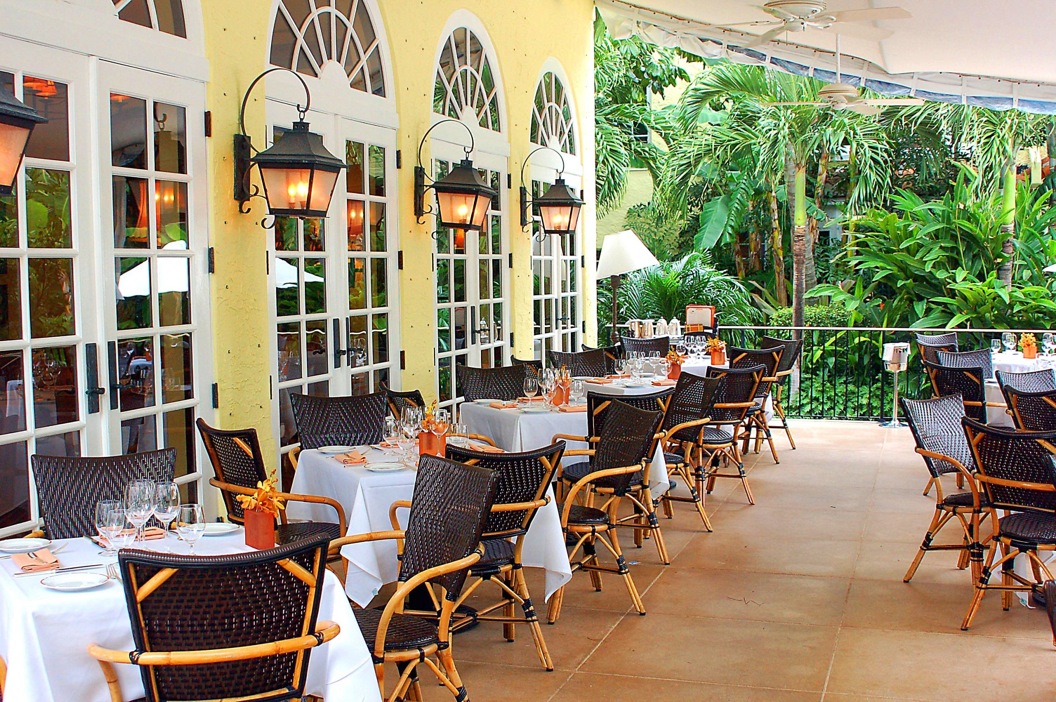
There’s dining outdoors on a palm-fringed patio overlooking a large fountain as well, but we’ve never been able to pass-up that comfortable, elegant, contemporary interior. The unruffled, faultless service staff and the warm greeting of General Manager Laurent Chevalier, who never fails to make one feel like an old, loyal friend, help as well. Finally, of course, there’s fabulous food, always fresh, always inventive, and always delicious. For Palm Beach, Boulud chose just the right, Executive chef, highly-talented Zach Bell from the NYC Cafe. And if Le Patron himself is in town and in the dining room, passing from table to table, greeting his guests with that Gallic warmth, charm, and ease of manner, that make Daniel so engaging, then a great meal becomes even more memorable.
Menu
items
are
listed
under
four
headings:
La Tradition, La Saison, Le Voyage, and Le
Plus
simple. I should know better than ever to equate simple with
uninteresting,
especially
here,
but
I
must
admit
to
a
bit
of hesitation before
ordering the tomato risotto with olive oil confit heirloom
tomatoes,
Grana Padano and basil. What arrived was one of those
deceptively uncomplicated, understated, as well as unexpected dishes,
with such
clean, unadulterated, captivating flavors: ripe, fresh tomatoes,
perfectly
cooked rice, fresh basil and yummy shards of Grana, and such
economy of
means, as only the best of chefs can create.
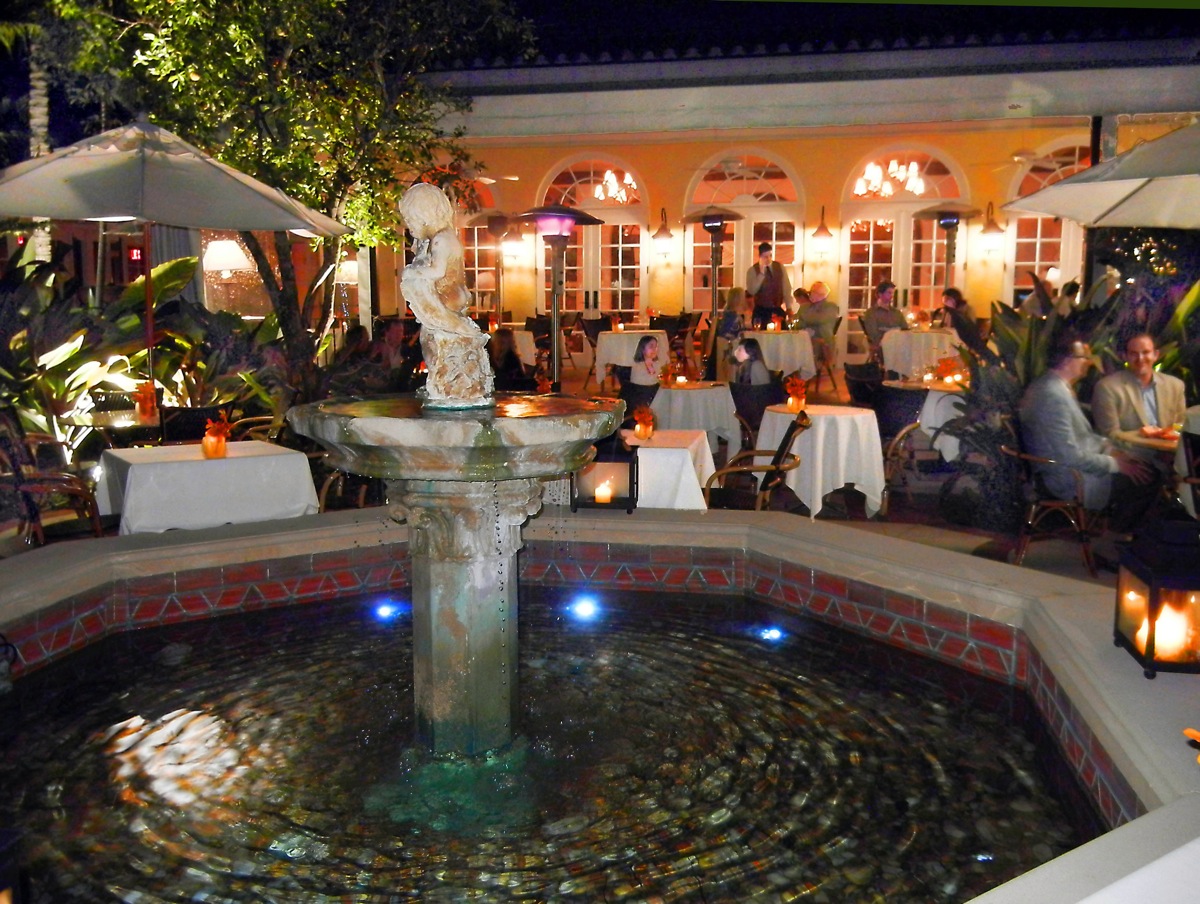 On
Le Voyage we found Octopus à
la
plancha,
nicely
grilled and tender, served atop a wonderful “salad”
containing chick peas, potatoes, red onions, piquillo peppers,
in a
smoked paprika aïoli, all of it sparked by the
addition of
Spanish chorizo. Grilled local mahi with a
fricassée of haricots verts, fingerling potatoes, and a
fresh
dill/horseradish soubise was
a perfect piece of fish, all but swimming with freshness, in the setting it deserved. Saddle of rabbit was also
rewarding, stuffed with a paste made
from its
innards, on a bed of fava beans in a pool of creamy grits with brown
gravy. Only
a side dish of chickpea fries was disappointing, the big thick fries
without
much of a crunchy crust.
On
Le Voyage we found Octopus à
la
plancha,
nicely
grilled and tender, served atop a wonderful “salad”
containing chick peas, potatoes, red onions, piquillo peppers,
in a
smoked paprika aïoli, all of it sparked by the
addition of
Spanish chorizo. Grilled local mahi with a
fricassée of haricots verts, fingerling potatoes, and a
fresh
dill/horseradish soubise was
a perfect piece of fish, all but swimming with freshness, in the setting it deserved. Saddle of rabbit was also
rewarding, stuffed with a paste made
from its
innards, on a bed of fava beans in a pool of creamy grits with brown
gravy. Only
a side dish of chickpea fries was disappointing, the big thick fries
without
much of a crunchy crust.
A
beautifully
presented
assiette de
fromages included Casatica di bufala, an unusual
washed-rind cheese
made from water-buffalo's milk
in Northern
Italy, near Bergamo; Cacio di Roma, a classic Italian table
cheese,
semi-soft, and made from pasteurized ewe's milk in Lazio; Brebis
des Pyrenées, a French, hard-rind cheese,
made in the
Basque country and the region of Béarn; and finally, a
Fairbault blue cheese,
Amablu,
needing no italics since it comes from a dairy in Minnesota.
OMG, dessert too! An upside-down chocolate soufflé, warm and gooey inside, and a scoop each of vanilla gelato, and passion-fruit sorbet, both richly flavored and well worth the caloric intake. And, after all this, came the not-to-be-passed-over-lightly petits-fours, a lovely passion-fruit gelée, one of those wonderful, crunchy, thin-crusted Parisian macaroons, an exquisite miniature financière, and similarly scaled quatre quarts (pound cake), a rich, dense, chocolate truffle, and, for me, the pièce de resistance, a beautiful, blushing pink, raspberry-flavored marshmallow. I’m always pleasantly surprised, as well as impressed, when a pastry chef, here Arnaud Chavigny, takes the time to make something sublime out of that humblest, and, so often, awful, of childhood indulgences, the marshmallow.
Starters:
$14 to $24, main courses: $33 to $48, desserts: $11 to $15.
 For a complete
change
of pace, a visit to the Omphoy Ocean Resort
is in
order. Mention the Omphoy in town, and the first thing you’ll hear is
“South
Beach in Palm Beach.” Certainly, the boutique hotel brings an entirely
new and
unexpected resort experience and design esthetic to Palm Beach, but
you don’t
have to be among the young, or ultra-hip to appreciate its
up-to-the-minute
décor.
For a complete
change
of pace, a visit to the Omphoy Ocean Resort
is in
order. Mention the Omphoy in town, and the first thing you’ll hear is
“South
Beach in Palm Beach.” Certainly, the boutique hotel brings an entirely
new and
unexpected resort experience and design esthetic to Palm Beach, but
you don’t
have to be among the young, or ultra-hip to appreciate its
up-to-the-minute
décor.
After the bright sunlight outdoors, entering its dark interior leaves you momentarily “blinded.” But this juxtaposition of darkness and light is, of course, the whole point. With a good stretch of the gorgeous, sun-drenched, Atlantic right out back, the designers wanted to provide guests with a shady retreat once inside. One goes from the bright, shining sun and shimmering sea of eternal “high-noon” outside, directly to dusky evening, verging on nightfall, within, and to the welcome shade of a cavern-like lair, or den.
Once inside, on the ground floor, you feel you’ve entered a rather roomy, rather posh cave, one that surrounds you with towering, dark brown walls, dark wood flooring, soaring ebony pillars, a “floating” stairway to the first floor, and, from underneath it, the gentle sound of falling water, and at the very back, small expanses (that, after a moment, reveal themselves as windows) bright with sunlight.
The
rear
elevation,
facing
the
beach,
is
especially
beautiful,
in
its
purity
and
economy:
large,
deep cobalt blue, oblongs of glass, are framed by a simple,
slender,
bright-white, horizontal grid. Hallways shroud you in darkness, their
walls, either large sheets of steel, oxidized so they have a gorgeous
prismatic
sheen, like that left by a gasoline-slick, or long expanses of soft,
deep brown
suede. The guestroom floors, of bronze-infused, porcelain tiles, are
cool to
the foot, virtually indestructible, and give the room a clean, carefree
feel.
Our
room
was
a
large,
dusky
rectangle,
with
a
dazzling
wall
of
sunshine
at one end, where
French
doors opened onto a private terrace large enough for two beach
chairs
and a
small table and its unobstructed view of the ocean close by. A big,
comfortable king-sized bed of dark wood sat in the center of the room
with
furniture of the same hue all around. The Omphoy’s
stretch of
the Atlantic, right out back, was gorgeous, but charging guests $20 a
day to rent the beach umbrellas was a little much.
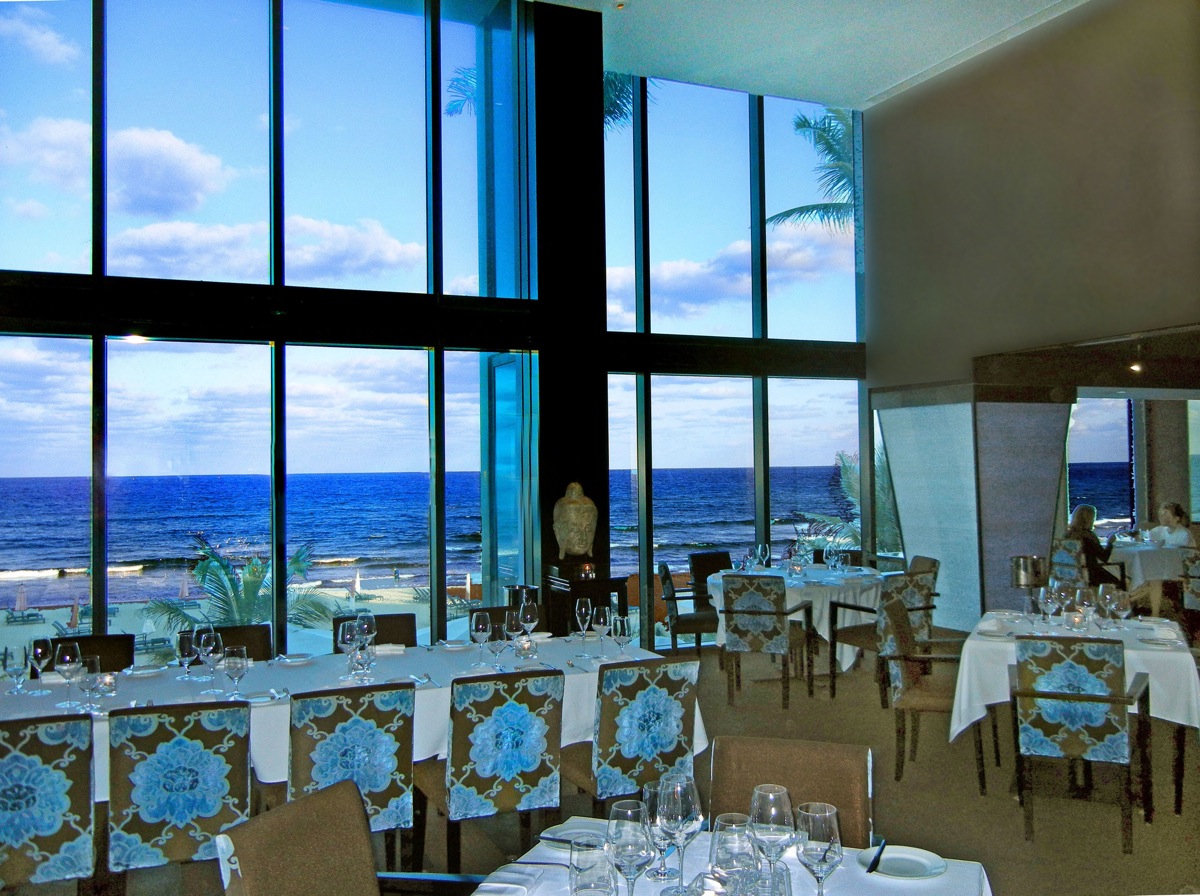 The signature
restaurant here is called, simply, Michelle Bernstein’s at the
Omphoy (left). The highly
acclaimed Bernstein did exceedingly
well in her choice of Chef de cuisine for the space, Chef Lindsay Autry. Lovely, petite, and looking
younger than her 28
years,
Autry joins an iron will with a determination twice her size. Jpeg
photos of a
particularly good catch--many a good bit larger than she is--are
routinely
e-mailed to her by local fishermen.
The signature
restaurant here is called, simply, Michelle Bernstein’s at the
Omphoy (left). The highly
acclaimed Bernstein did exceedingly
well in her choice of Chef de cuisine for the space, Chef Lindsay Autry. Lovely, petite, and looking
younger than her 28
years,
Autry joins an iron will with a determination twice her size. Jpeg
photos of a
particularly good catch--many a good bit larger than she is--are
routinely
e-mailed to her by local fishermen.
Cobia, a regional fish, was impeccable, with firm, sweet flesh, all but jumping off the plate with freshness. Ditto the wild striped bass, again with a satisfying, firm, meaty texture. With the first course came ethereal gnocchi alla carbonara, light, airy, and so good they could have been an entrée by themselves, with slivers of delicious jamon Serrano, and shitake mushrooms; the bass came atop a farro “risotto,” studded with good-sized chunks of lobster and tasty chorizo. Autry puts her reputation squarely on the line by offering fresh Sardines, and comes out a winner. Their clean, briny taste and texture are irresistible, and have nothing to do with those oily things that come in a tin. Chef Autry has them Fed-exed from Spain or Portugal. These were perfect, nicely grilled, and served --one big one-- on bruschetta along with local heirloom tomatoes in a vinaigrette with just the right, clean acidic bite to enhance their flavor, and a little crunch to round out the dish.
A
thousand
olés as well for her
Florida tomato gazpacho. Someone’s been to Spain: here was
true gazpacho, a light to medium-bodied liquid, smooth
as silk
and as
refreshing as a cool
drink of water. In torrid Seville where I first had it, it’s served
cold, with
an ice cube floating in the middle to keep it that way. You taste each fresh
vegetable--tomato, bell pepper, and cucumber, yet the
flavors all mesh
easily one into the other, and what emerges is a seamless, supple
whole. I had to stop myself from adding an ice cube.
Tender calamari à la plancha came
with scampi-style risotto--an inspired idea--and crispy garlic, but
the
calamari part was either tiny bits of the body or small bunches of
tentacles,
and, either way, not particularly tasty. Sweetbreads are also on my
shortlist of
dishes to order whenever they appear on a menu. Not a bad gauge of the
kitchen’s commitment, they must undergo a long
pre-preparation; only
then are they ready for grilling or sautéing. Once again, the
crispy
sweetbreads here hit the mark, wonderfully tender, and served with
braised beef
cheeks, certainly the most tender part of the cow there is.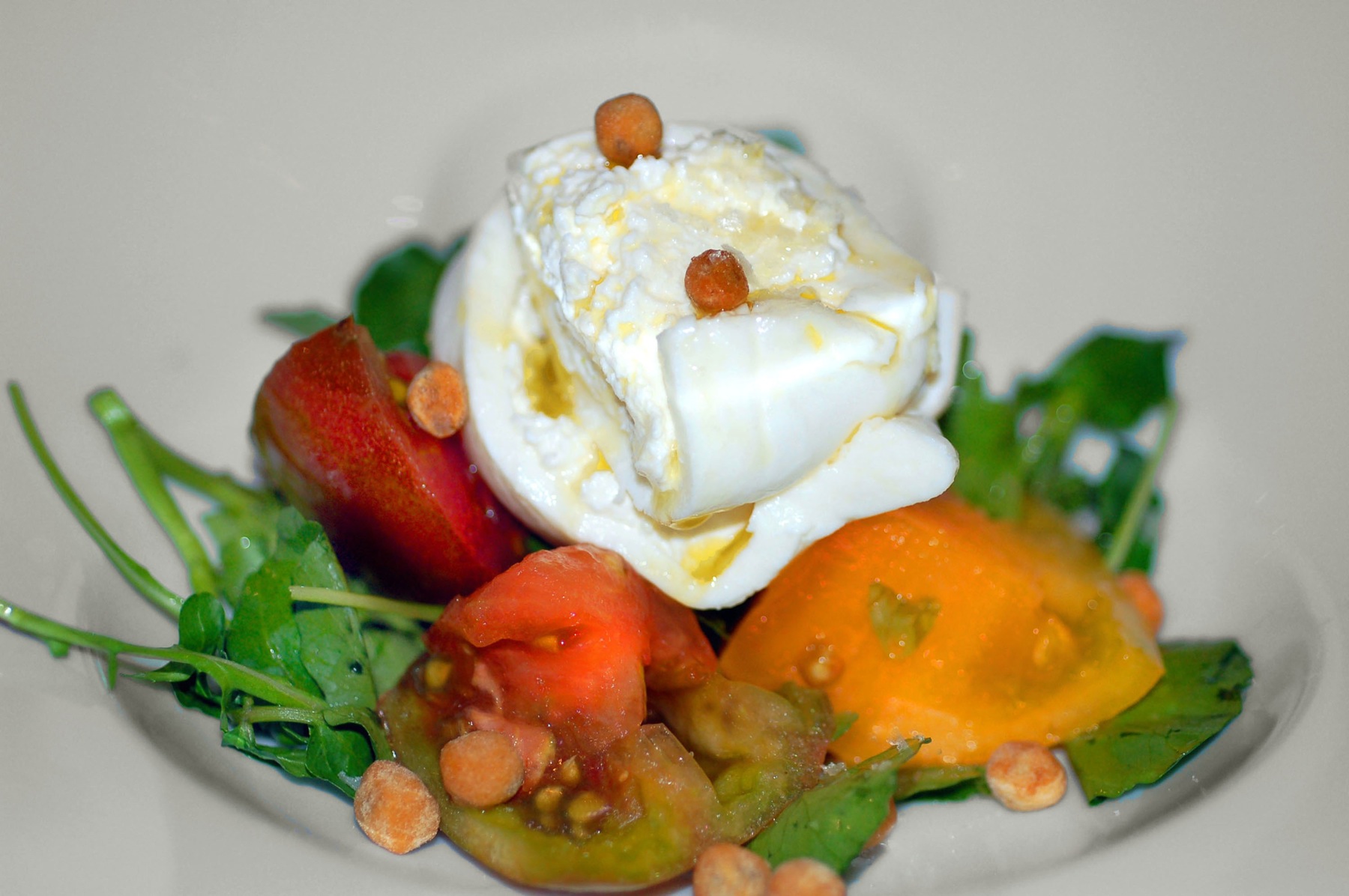
It
may
be
an
uphill
battle
in
such
an
elegant
venue,
but
Autry
keeps Michy’s fried chicken on the
menu, much to her guests’ delight. The buttermilk-marinated
Southern-fried
chicken was super-crunchy from the cornmeal in its coating
and juicy within. What could be more appropriate with it than
mac-and-cheese and coleslaw?
For dessert? Hot chocolate-filled doughnuts with a
caramel pot de crème and chocolate crunchies, three
perfectly
spherical, sugared beignets enclosing
small pools of thickened, high-quality hot chocolate. As good, and as
beautiful on the plate,
were a Meyer lemon tartlet with pistachio ice cream, citrus
and
pomegranate syrup, as well as a light-as-a-feather Angel
food cake
atop honey roasted pineapple--certainly a case of gilding the
lily--with
sweetened crème fraîche.
A
Vincent
Girardin,
Chassagne.-Montrachet Vieilles Vignes, $99,
was a good, satisfying red
Burgundy, while the Numanthia Termes: $65, shows why
the International Style, done
right, is so
attractive, when some kind of structure, whether from acids, tannins,
or both,
balances opulent, upfront fruit, as do lovely, secondary notes of
cedar, smoke,
and spice.
Starters: $12
to $20, mains: $30 to $38,
desserts: $8 to $10.
PALM BEACH'S NEWEST HOT SPOT
by John Mariani
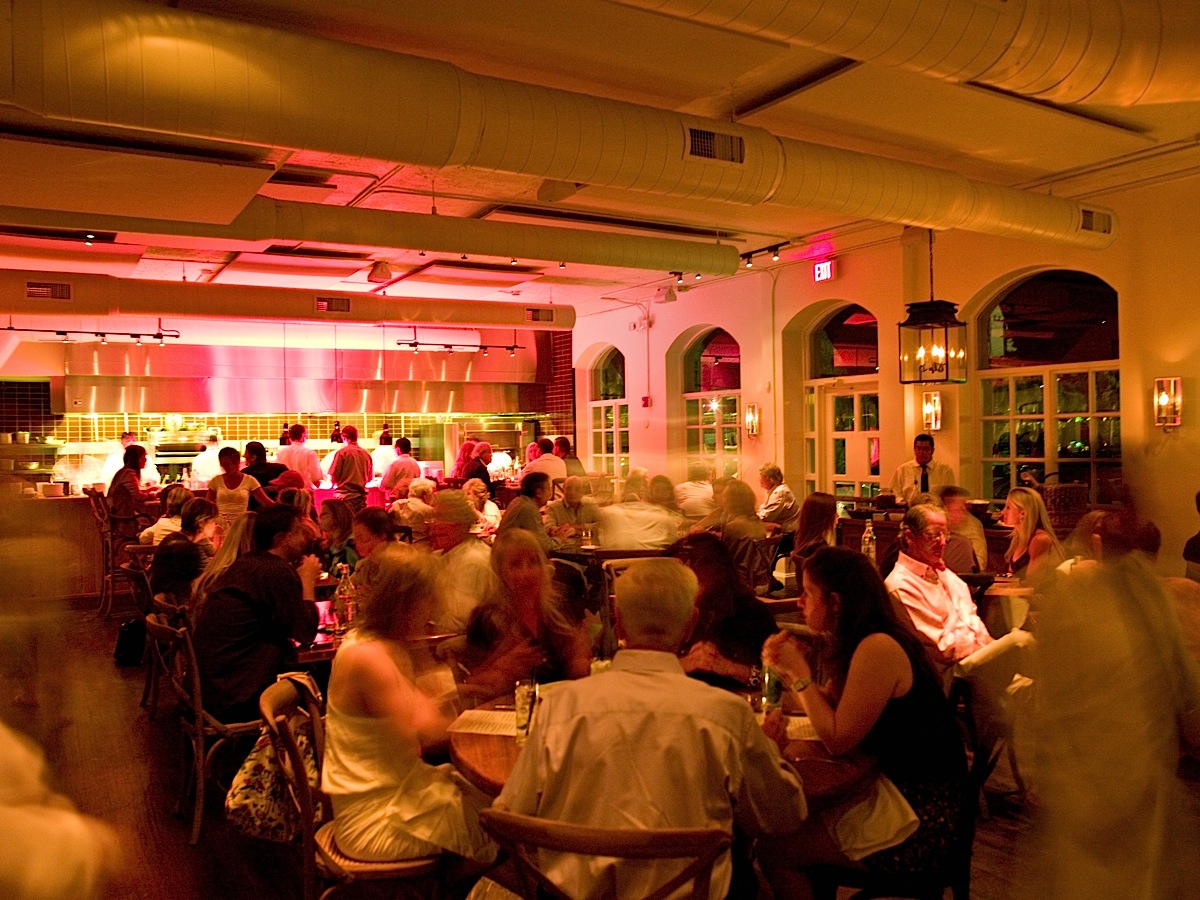 būkkan
būkkan350 South County Road
561-833-3450
www.buccanpalmbeach.com
For all its conservative traditions, Palm Beach residents are as eager as visitors to hit the newest restaurants and bars in town, and the brand new 160-seat Būccan has been packing them in since opening in January, at the start of the high season. Yet even now, well past the spring and into the sweltering Florida summer, the place is still jammed every night, as I found out on a recent Friday visit.
I made a special trip up from
Miami just to eat at Būkkan
principally because I have so admired chef-partner Clay Conley's
cooking in the
past when he was at Azul in Miami, where he was doing some of the most
refined
cuisine in the city. Here at Būccan (a word that refers to a Caribbean
grill-like apparatus, a progenitor of a barbecue) he is going far more
casual with what he calls a "Progressive American Grill."
The
room is
done up in sandy colors, with lots of soft pillows, couches and
banquettes,
muted but consistent lighting that allows you to see everyone coming
and going, the whole of it done with accents
of copper, stone, and
mercury glass. Tables are polished copper and wood. It all
fits
nicely into contemporary Palm Beach with a distinctly casual feel that
draws people
from the area, the oldtimers in Lily Pulitzer and Ralph Lauren,
the younger generation in Versace and Tommy Hilfiger, with scads of
women 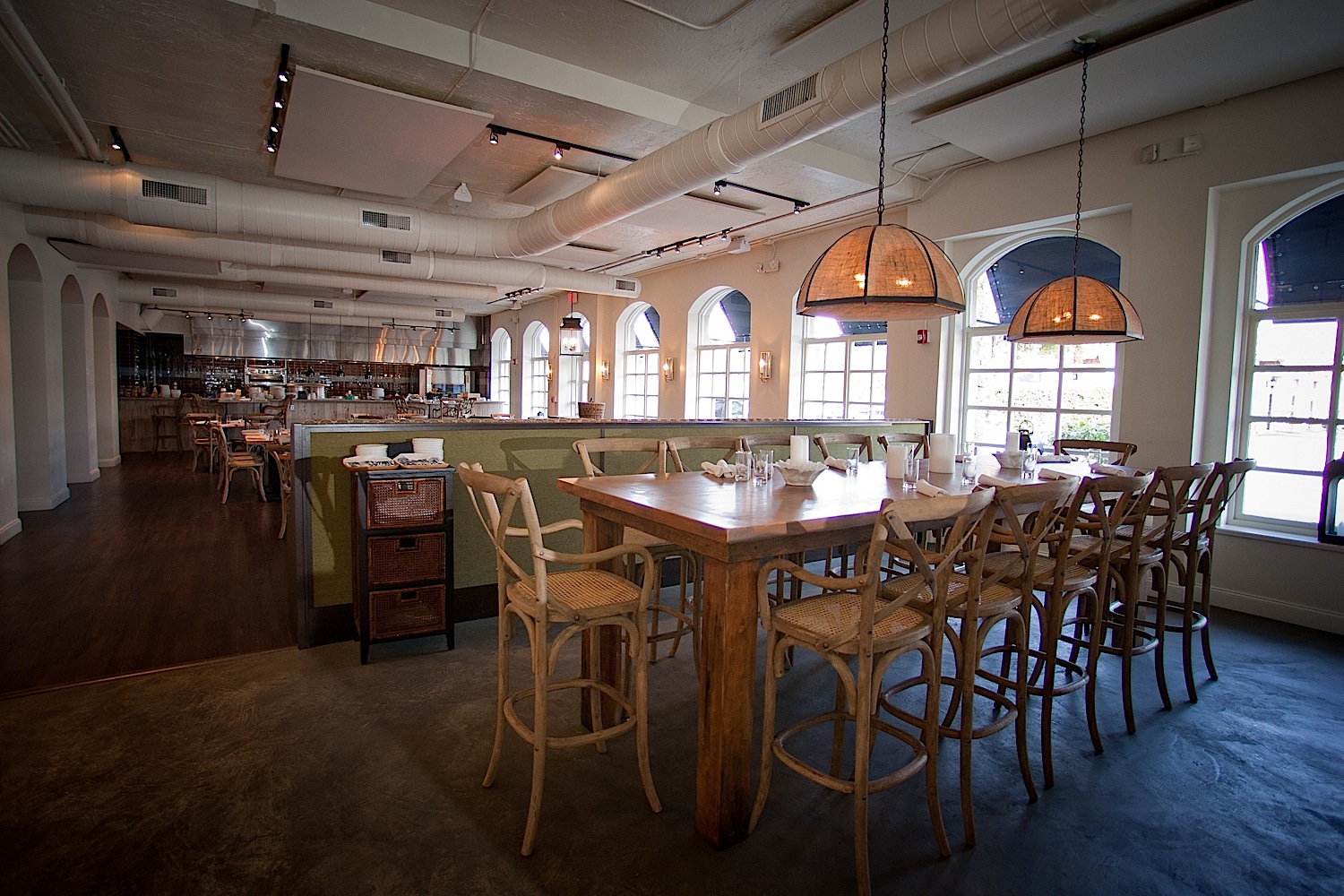 who
dress to the nines here. Deep tans, from beach, booth, spray, or
bottle, seem de rigueur.
who
dress to the nines here. Deep tans, from beach, booth, spray, or
bottle, seem de rigueur.
Clay (below) and his crew turn out food at a furious pace, starting with tapas-like pinchos of cheeses, hamachi sashimi with chilies, really delicious tuna poke with coconut, gingered carrot, and jalapeno, and a succulent, sweet petite lobster roll. Under the “Crispy Flour & Water” category, the menu offers whipped ricotta ravioli (too soft) with truffle butter, sweet peas, and a Port syrup, as well as spinach-tomato gnocchi with crispy prosciutto. The Thai beef salad is better than most I've had in Thai storefronts.
But
the
grill is clearly the centerpiece here, and the woodfire-roasted
mushroom-Gruyère-onion pizza with a black truffle vinaigrette
comes forth
from that fearsome oven just right, crisp and bubbly, everything well
melded. Popular grill
items like tender octopus with creamy tabbouleh and black garlic, and
barbecued
quail with a delectable Cheddar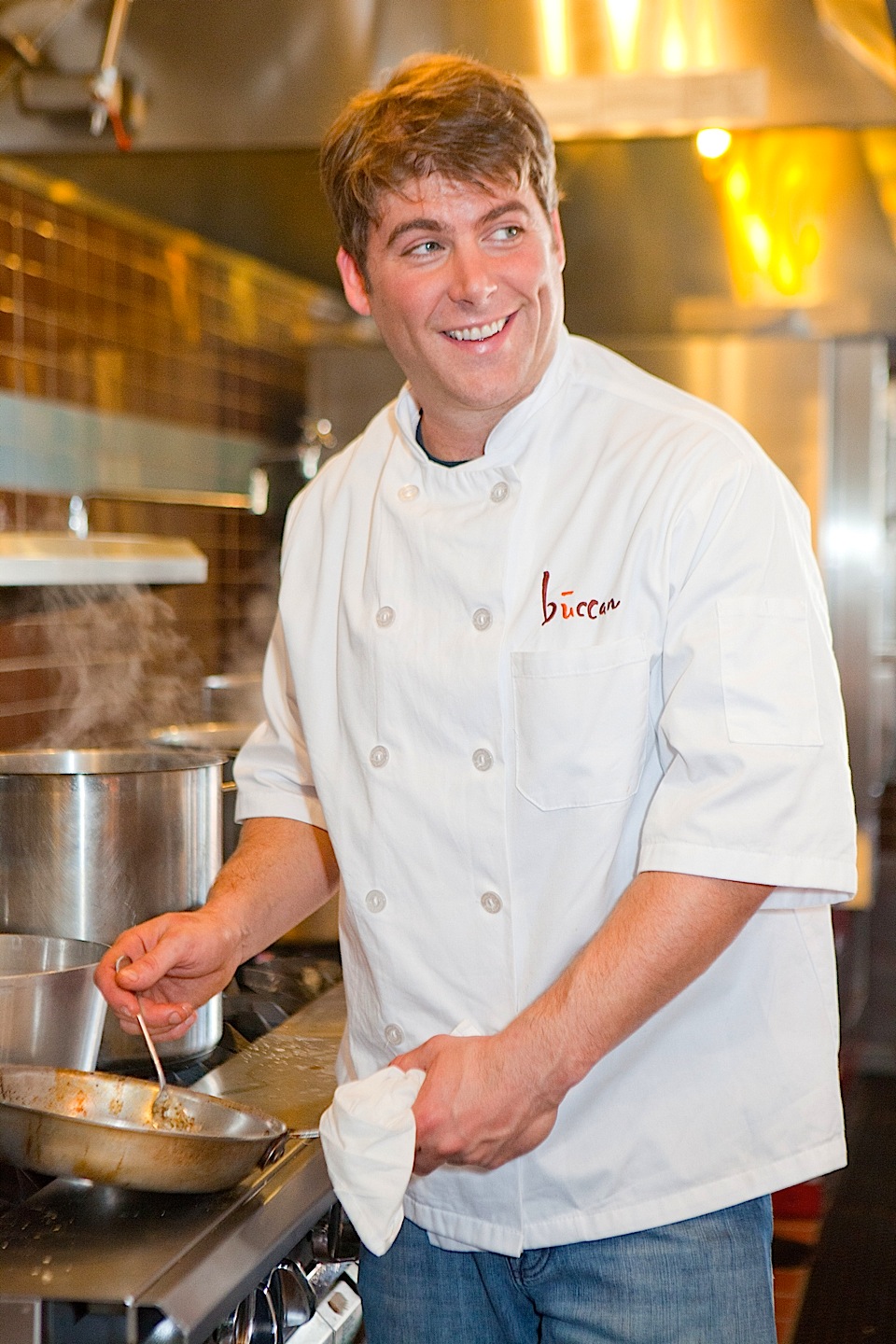 biscuit and irresistible creamed
corn with
bacon are really good. The lamb scottaditti--which
means
biscuit and irresistible creamed
corn with
bacon are really good. The lamb scottaditti--which
means
“finger burners”--were not as small as they are in Italy
or Spain where you pick them up
with your fingers; nevertheless the meat is of excellent quality,
served with a spicy harissa sauce.
Shortrib
empanadas are not to
be
missed, with a salsa criolla and
aji amarillo
chile. For something different and of the season right
now, try the bacon-wrapped local peaches with an orange-finger glaze,
blue
cheese and greens—the epitome of Floridian wholesomeness done with real
flair.
There are
large plates too, about five of them, and I highly recommend them as
well,
including a yellowtail snapper with bok choy, green curry and white
rice, a
very juicy rendition with good flavor components.
There are only five desserts, each likely to add a
muffin top to a bikini, but they are worth the extravagance, especially
the tangy-sweet Florida Key lime tart with yuzu and whipped cream, and
the peach and blueberry crisp with almonds and ginger ice cream.
Būkkan is clearly filling the summer season
laziness with both an enticing nightlife and dinner, and Clay seems to
have hit on a formula that will keep the place growing when it opens
soon for lunch and brunch.
Būkkan is open nightly
for dinner. Small plates $4.50-$15, large plates $15-$30.
TO
READ PART ONE OF THIS ARTICLE CLICK HERE.
❖❖❖
by John Mariani
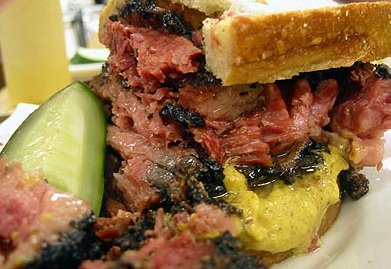
WHAT'S NOT SO NEW UNDER THE NEW YORK SUN
by
John
Mariani
The
hand-cut
pastrami
on
rye
at
Katz's
If
you read the current foodie hipster columns and food dude blogs, you
would
think that we are in
a Golden Age of food carts, pop-up eateries, hamburger stands, sandwich
shops,
diners, taco stands, and pizzerias. In
fact, the only thing that’s new about any of it is the
media hype
about well-known chefs and restaurateurs who have deserted or diverted
their
attention from upscale dining in order to run cheap eateries whose
customers
will line up for hours to get their hands on a bánh mi sandwich or an
artisanal
cupcake.
One
thing is clear: Those same types of eateries have always been part of
American
gastronomy, and in particular NYC’s food landscape, but they were
rarely
treated with much respect. Indeed,
twenty years ago you would not have found the New York
Times or Gourmet
Magazine or Bon Appetit singing the
praises of a pop-up food truck in Astoria or a hamburger stand in Union
Square. Yet two years ago Travel
&
Leisure’s pick of 50 Best
new restaurants in America included “a hipster BYO nook” called Urban
Belly in
Chicago, Co. pizzeria and a “barn wood-clad cubby hole” called Txikito
in NYC,
and a “breakfast and lunch joint” named Brenda’s French Soul Food in
San
Francisco. 
I
am perfectly happy that such establishments get high attention, but the
United
States of arugula foodie hipsters have developed not just a mania for
hole-in-the-wall
eateries but have done so by disparaging upscale restaurants that dare
to serve
food on matched china, tablecloths and silverware in surroundings of
stunning
décor and menus that go way beyond six types of pork sandwich
and eight pizza
toppings.
NYC
has always been the crucible for such eateries—with the exception of
the
original pop-up eatery, the roll-in at night and roll-out in the
morning Pioneer
Lunch Wagon in Providence, RI, back in 1872. The
first
pizzeria
in
America,
and
still
one
of
the
very
best,
is G. Lombardi’s, opened
on Spring Street in 1905. As of 1832 NYC’s
had a Street Spa that
dispensed eight flavors of soda, and Yorktown was lined with
wurst-and-beer
houses, prefiguring today’s gastropubs. The Automat began in
Philadelphia, but flourished in NYC: by 1939 there were 40 of them
around town.
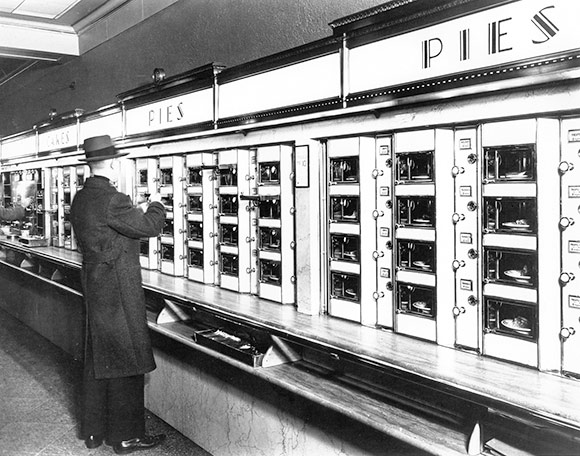
NYC
didn’t invent the hot dog but Nathan’s in Coney
Island perfected it, and theirs is
still the most delicious frank in town. Jewish
immigrants
gave
the
city
its
delicatessens
like
Katz’s
on Houston
Street where sandwiches are piled high with hand-cut pastrami that has
never
been improved on. Dim sum parlors
have been part of Chinatown’s ethos for a hundred years, and in the
1950s,
immigrant Puerto Ricans opened coffee shops and eateries on the West
Side,
sometimes combing their offerings with Chinese items, a sub-genre
called
Chino-Latino. Harlem storefronts have been dishing up fried chicken
since the
1920s, and Russians really did run tea rooms.
One
magazine that has, almost from the start, covered all such places is New York, whose current issue’s cover
story is “Eat Cheap” by Rob Patronite and Robin Raisfeld, which
includes a
story called “Devouring Queens: One Couple’s Search for the Best
Sichuan, Thai,
Korean, Indian, Mexican, [etc.]
in
the
City’s
Ethnic-Food
Mecca.” This
shouldn’t be surprising
since from the magazine’s inception in 1968, Milton Glaser and Jerome
Snyder
continued their “Underground Gourmet” column in its pages, writing,
when the
driving force behind it was that the restaurants
were cheap—at first two
dollars or less, as low as fifty cents. 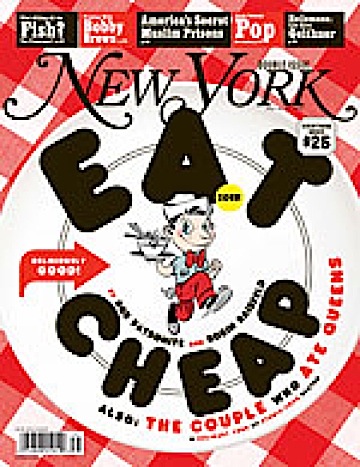
There
were 101 restaurants in the columnists’ collection in book form (below), including
Focacceria on the Lower East Side, Gefen’s Dairy on 7th
Avenue, Tel
Aviv on East Broadway, and the Belmore Cafeteria on Park Avenue South.
Glaser
and
Snyder
wrote,
“No
city
equals
New
York
in
its
fantastic
assortment of good, cheap restaurants. . . . Ethnic
restaurants are
knowledgeable about their national cuisine and establish the standards
of their
indigenous eating places. A
Hungarian restaurant run by a Hungarian and frequented by the residents
of a
Hungarian community will in variably serve a food bowl of goulash at
the right
price. . . . The cheap, good
restaurant, ethnic or not, is an indispensable part of the character
of New
York and, like other treasured landmarks, should be preserved.”
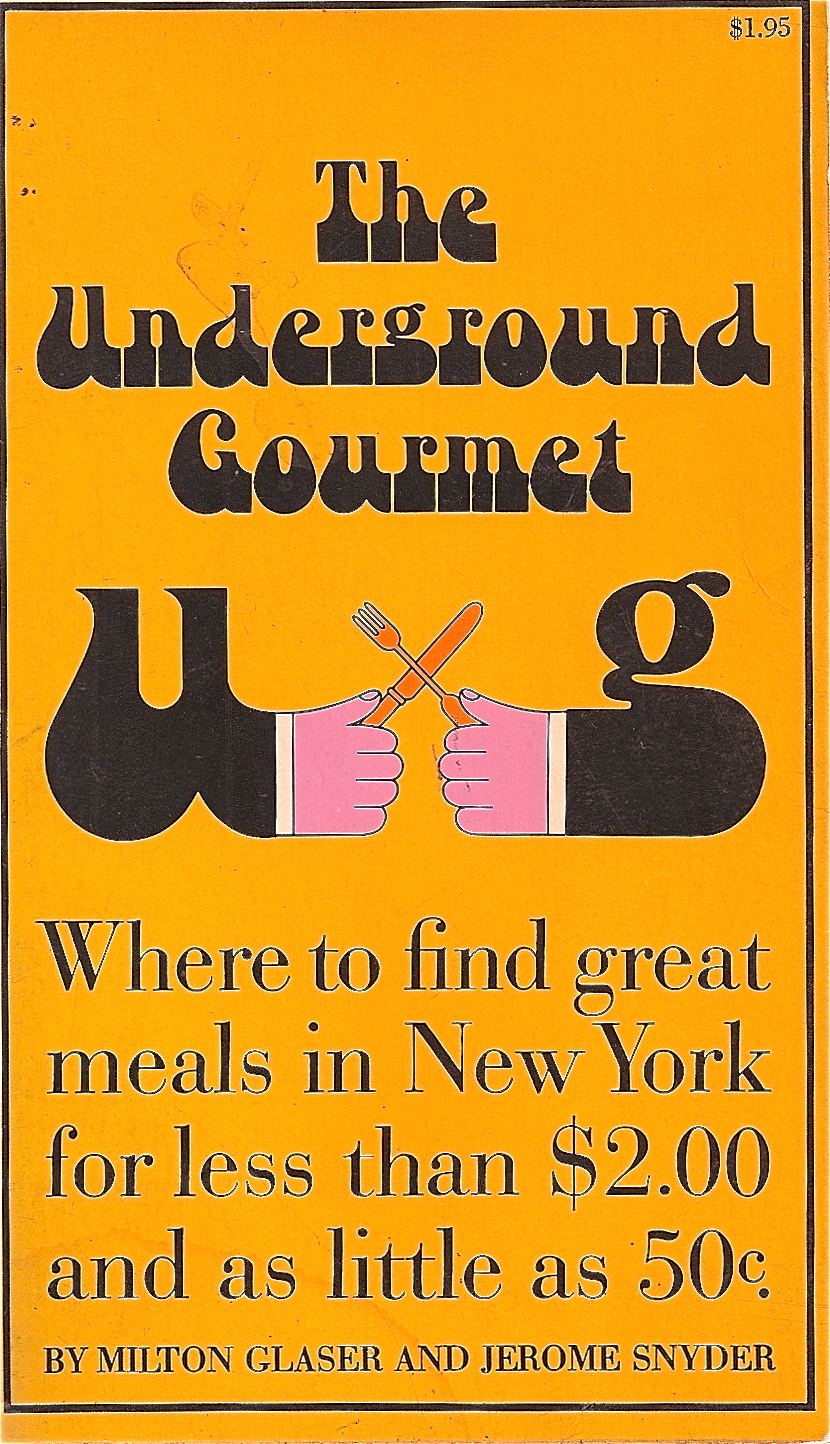 Explicit
in
those
statements
is
the
answer
to
contemporary
food
writers
who
insist
chefs
and cooks trained in high-end kitchens will invariably turn out food
better
than those ethnic cooks who learned their craft from decades, even
centuries of
culinary tradition. Most of the
places Glaser and Snyder wrote about are long gone, though some, like Yonah
Schimmel Knish Bakery and the Pink Tea Cup are still
around.
Explicit
in
those
statements
is
the
answer
to
contemporary
food
writers
who
insist
chefs
and cooks trained in high-end kitchens will invariably turn out food
better
than those ethnic cooks who learned their craft from decades, even
centuries of
culinary tradition. Most of the
places Glaser and Snyder wrote about are long gone, though some, like Yonah
Schimmel Knish Bakery and the Pink Tea Cup are still
around.
The
problem these days is that the restaurants so ecstatically hyped by the
food media can be anything but cheap. A
curry lobster roll at Miss
Lily’s on Houston Street will run you
$18, a diavola pizza at 900
Degrees in the West Village on goes for $18, and a pulled pork platter
at Mable’s Smokehouse
in
Williamsburg is $14.95. Have an appetizer, dessert, and drinks for two,
and
you’re looking at a $70 bill.
I’m
glad all these places exist and I’d eat at any of them when I’m in the
mood for
food I can’t get at Le Bernardin or Del Posto. But
NYC
has
always
has
been
blessed
with
hundreds
of
out-of-the-way
or
smack in-the-way restaurants that exemplify not a
melting pot
but a stew pot of world cultures. And it
has been that way since the Gilded Age when NYC welcomed millions of
immigrants with open arms and plenty of opportunities.

MAN ABOUT TOWN
by
Christopher Mariani
Spain's Rail Sytem
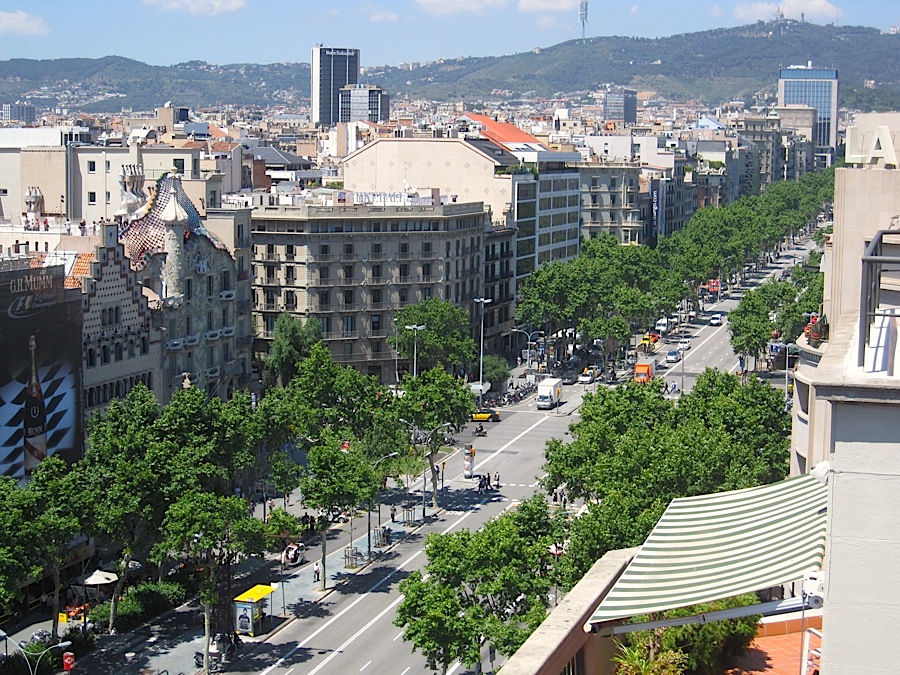
I recently returned from Spain where I visited Madrid, went on to the lively city of Barcelona, made my way south to Valencia and finally back north to Madrid before flying home to New York. This destination triangle is a terrific way to experience three distinctly unique cities.
Madrid, the capital, is packed with beautiful architecture, a newly constructed over-the-highway lush green park and charming little neighborhoods where you can sit outside, enjoy a glass of wine and grab a bite to eat. Barcelona, a shopper’s paradise, is a dynamic city right on the Eastern coastline of Spain, fueled by the city’s youth, full of tasty little tapas restaurants and chic outdoor cafés. Valencia is a culturally rich city known for its stunning cathedrals, magnificent museums and a traditional dish called paella, slightly disappointing. If only the cuisine of Spain embraced garlic and spiciness, oh what a difference it would make.
All
three
cities
are worth a visit but they are not exactly close to one another.
Madrid
sits almost directly in the middle of Spain, Barcelona on the
Northeastern
corner of the vast country and Valencia, a good 200 plus miles south of
Barcelona, also directly on the coastline. The question is, how does
one get
from city to city with luggage, without paying astronomical fees and in
a very
short period of time.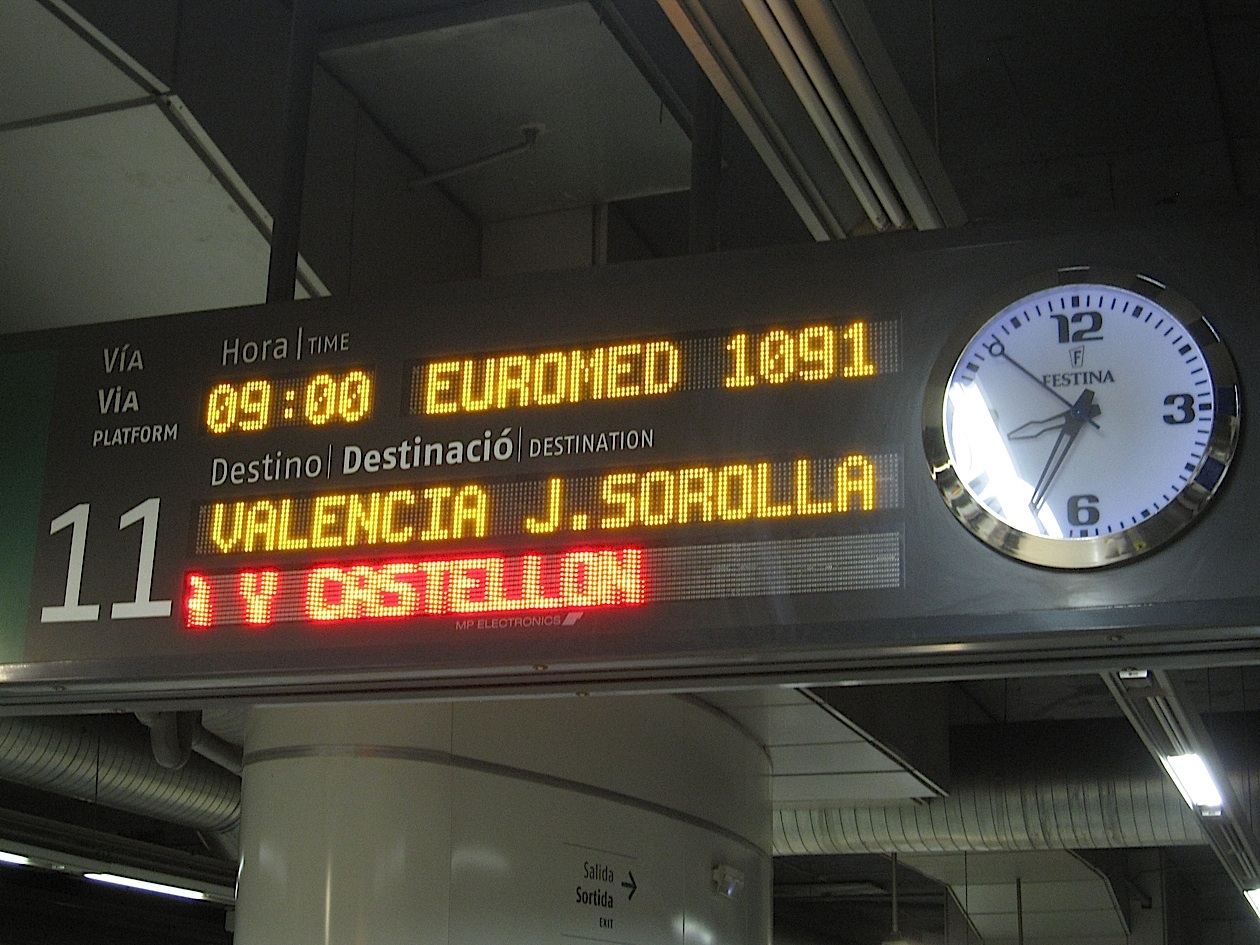
The
answer,
I found, is
easy: AVE,
the high-speed rail that is part of Spain’s rail system, RENFE. I
had always heard amazing testimonials regarding European railway
systems, but it
was not until this trip to Spain that I understood exactly why. Four
words wrap
up the railway experience: pleasant, comfortable, efficient and clean.
After touring Madrid, where I spent one night at the Intercontinental Madrid, my next stop was Barcelona. I woke up at 6 am for a 7 am departure and jumped in a cab heading towards the Atocha Madrid Train Station. Upon arrival I witnessed a bustling station filled with thousands of men and women getting ready for daily commutes to other cities around Spain. I found my way to the terminal and prior to boarding I grabbed a cup of coffee from the station’s café Ciao Restaurante. Twenty or so minutes before departure I was told I could board the RENFE train. Once onboard I took a look around and was delighted to see my quarters were extremely clean and well kept, all seats designed with ample leg room (keep in mind I’m 6'1") and giant windows to gaze out of once en route.
Traveling
first
class,
I was immediately offered a selection of newspapers and
magazines, asked
if I would like any water and given a genuine welcome from a very
pretty young
lady. Once out of the station, departing exactly on schedule,
unlike our wonderful train system here in the
States, the sun’s light filled the train car and we picked up speed in
a hurry. 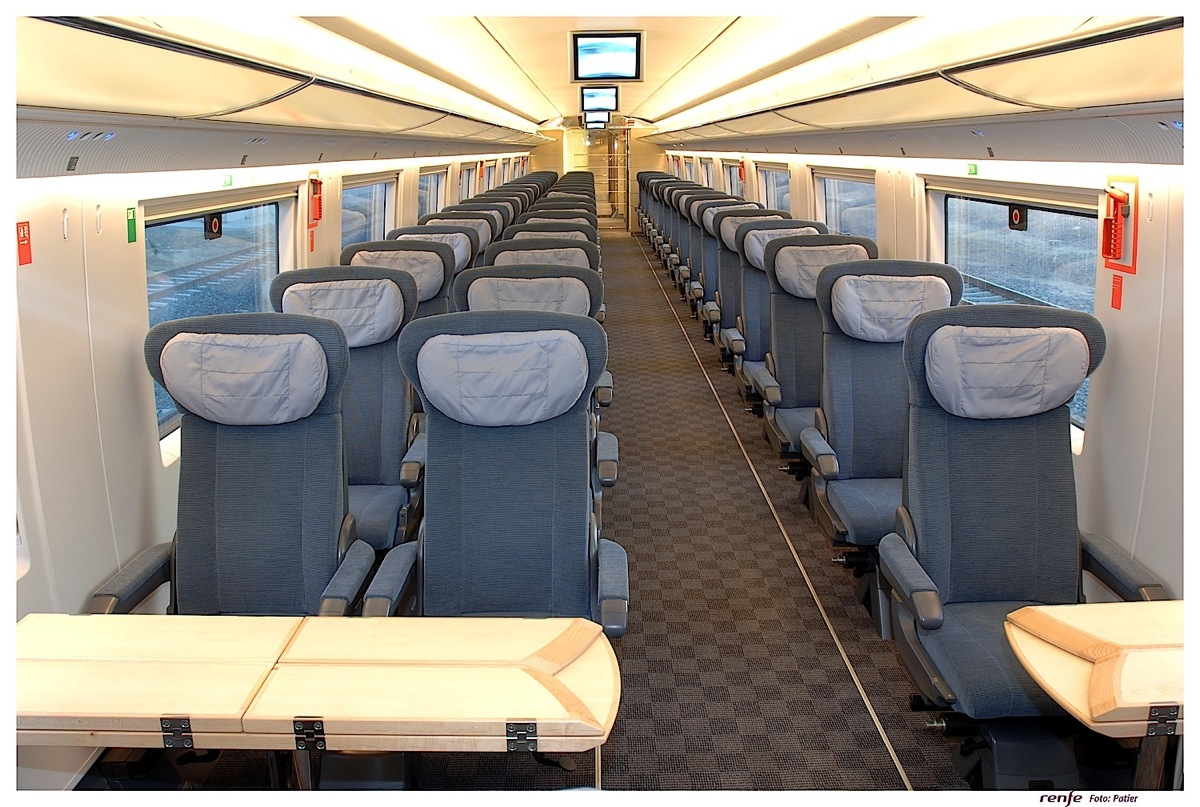 According
to the onboard speedometer, once out of the city, we were cruising
towards Barcelona at speeds upwards of 290 kilometers (approximately
172 mph)
and you don’t feel a damn thing. The train seems to glide through the
countryside of Spain as if floating above the steel rails below. There
was
almost no noise from the engine, just a peaceful hum in the background.
According
to the onboard speedometer, once out of the city, we were cruising
towards Barcelona at speeds upwards of 290 kilometers (approximately
172 mph)
and you don’t feel a damn thing. The train seems to glide through the
countryside of Spain as if floating above the steel rails below. There
was
almost no noise from the engine, just a peaceful hum in the background.
Just a few minutes into our travel I was handed a breakfast menu followed shortly by a breakfast tray filled with coffee, orange juice, an omelet, a selection of bread and lots of jam. The food was no better than that found on a mediocre airline but it was still a nice touch. After a few chapters of Hemingway’s A Moveable Feast, I drifted off to sleep after reclining my chair, and two hours later I woke up in Barcelona as the train quietly pulled into the station.
In Barcelona we checked into the Hotel Claris and had a very fine lunch at the Mandarin Oriental. That evening we walked until we found a cozy little tapas restaurant and ordered almost everything on the menu, twice. In the morning it was off to Valencia.
Out of the three train rides taken while in Spain, the Barcelona to Valencia trip was by far my favorite. The view is magnificent. Imagine, for two hours straight, looking out onto the ocean on one side and a gorgeous green landscape on the other. I probably should have slept but instead I took tons of pictures and stared out at the coastline while drinking a double espresso inside the bar car. It was blissful and the natural beauty of Spain will never leave my memory.
When
traveling
through
Spain, the AVE railway system is clean, quiet, efficient and
best of
all, nothing like the embarrassing railway systems found throughout
America
(although the Northeast does have nice trains). The beauty of traveling
through
Europe is that it is so easy. You are more than welcome to stand on
long security
lines at the airport, I’d rather take the train. Let’s see who gets
there
first.
 Rail Europe Inc., the largest
distributor of European rail products in North America, represents more
than 35 railroads and provides train travel in most European
countries, offering the widest range of passes and point-to-point rail
tickets. Rail Europe provides an efficient, cost and
time-effective
experience by letting customers purchase tickets and plan travel
details in
advance. Not only providing effortless access to the places you want to
visit
around your base country, but ease of travel to up to four of its
neighbors.
Rail Europe Inc., the largest
distributor of European rail products in North America, represents more
than 35 railroads and provides train travel in most European
countries, offering the widest range of passes and point-to-point rail
tickets. Rail Europe provides an efficient, cost and
time-effective
experience by letting customers purchase tickets and plan travel
details in
advance. Not only providing effortless access to the places you want to
visit
around your base country, but ease of travel to up to four of its
neighbors.
Choice of countries include: Austria, Benelux (includes Belgium,
Luxembourg,
The Netherlands), Bulgaria, Croatia/Slovenia, Czech
Republic, Denmark,
Finland, France, Germany, Greece, Hungary, Italy, Montenegro/Serbia,
Norway, Portugal, Republic of Ireland (includes Northern
Ireland),
Romania, Spain, Sweden, and Switzerland.
To contact Christopher Mariani send an email to christopher@johnmariani.com
Great
Burgundies
Need
Not
Cost
a
Fortune
by John Mariani
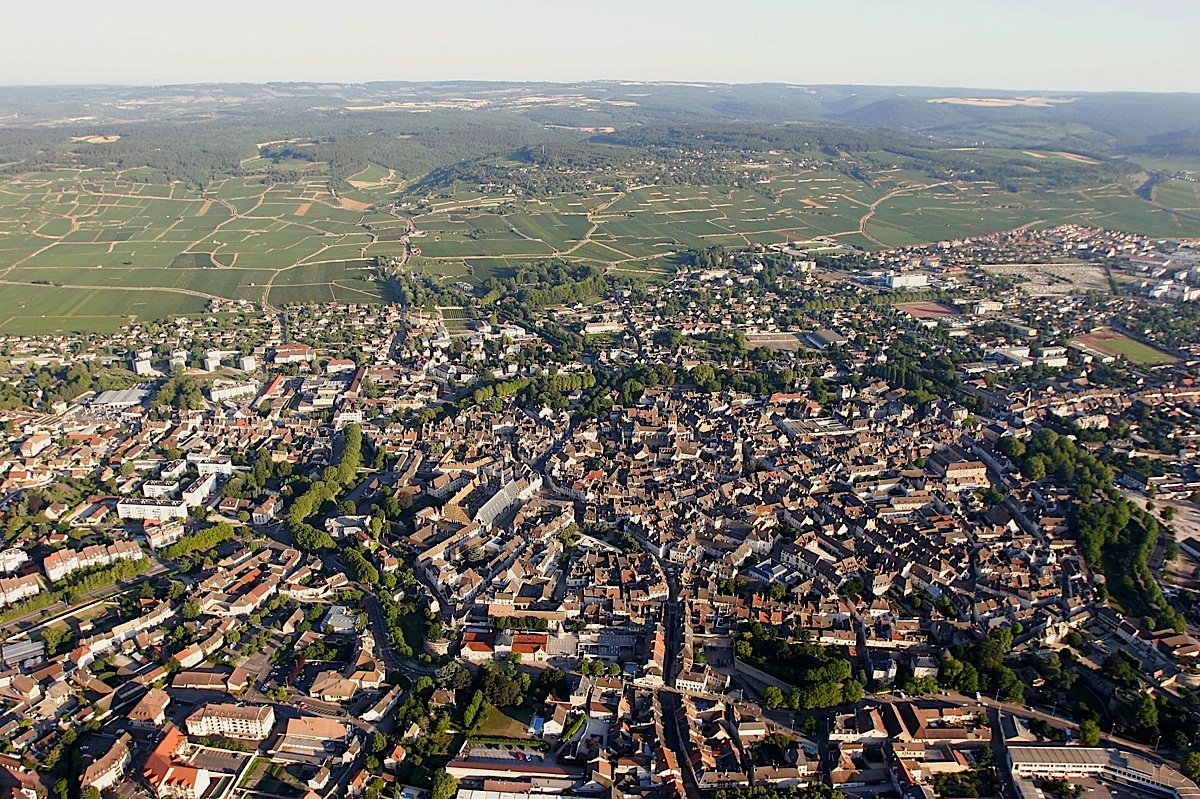
The City of Beaune in Burgundy, France
My advice to the budding wine enthusiast is to go out and buy a very good wine that is typical of its type, thereby having a standard by which to measure other wines, or, to carry the literary metaphor further, give a person Jane Austen or Ernest Hemingway and they’ll probably never go back to Barbara Cartland and Steig Larsson.
Thus, were I to recommend an introduction to fine cabernet sauvignon, I’d recommend a third- or fourth cru bordeaux or a Napa Valley estate in the $30-$50 range. For a premium Italian wine, a barolo or barbaresco. When it comes to chardonnay and pinot noir, however, I’d shy away from recommending big, flashy, oaky California examples and instead focus on French burgundies.
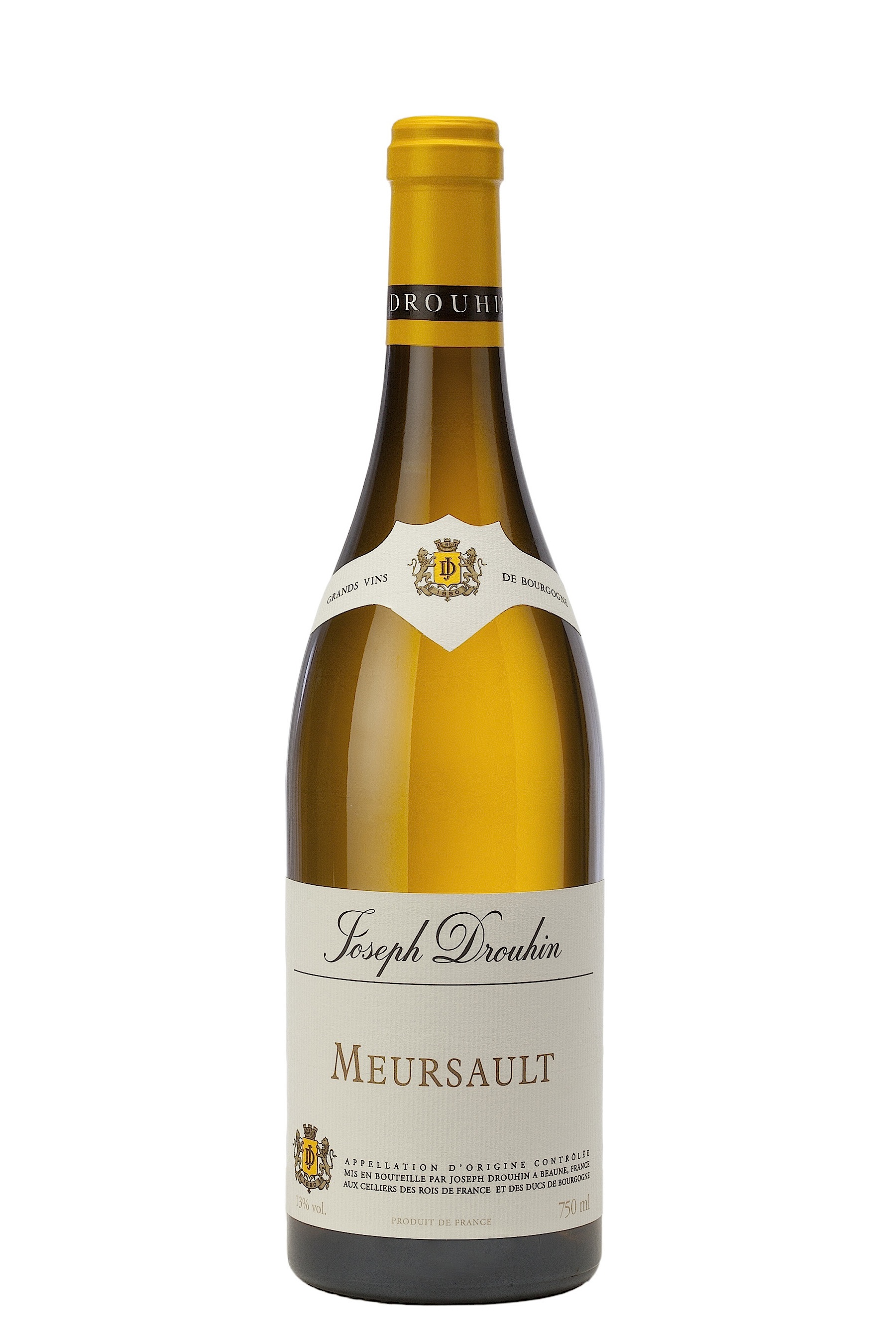 The
problem
is,
the
very
best
burgundies
are
out
of
reach
for
most consumers—a bottle
of
Romanée-Conti is running about $10,000—and, unlike the wines of
bordeaux, which
come from single estates, a single vineyard burgundy may be owned by
many
negoçiants (merchants) who buy the grapes, must, or wine then
make their own
blends bottled under their own label.
The
problem
is,
the
very
best
burgundies
are
out
of
reach
for
most consumers—a bottle
of
Romanée-Conti is running about $10,000—and, unlike the wines of
bordeaux, which
come from single estates, a single vineyard burgundy may be owned by
many
negoçiants (merchants) who buy the grapes, must, or wine then
make their own
blends bottled under their own label.
Becoming familiar with obscure burgundy negoçiants is a lifelong project, but many well-established companies like Bouchard Pere & Fils, Louis Jadot, Domaine Leroy, and Joseph Drouhin are not just readily available in the global market but produce a wide range of consistently good wines, including many of the most illustrious and expensive.
So on Father’s Day this year, I celebrated by opening two Joseph Drouhin bottlings, a 2009 Meursault ($45.50) and a 2009 Morey-Saint-Denis ($50), the first with spaghetti with a basil pesto sauce, the latter with a grilled veal chop. These are wines of enormous refinement, not to be drunk without food, and they vividly reminded me what I how distinctive Burgundian chardonnay and pinot noir can be.
The Meursault’s chardonnay grapes are picked by hand in various selected vineyards from “trusted growers.” They are then gently pressed and aged nine to ten months, using only 30 percent new oak barrels, so that the subtlety of the wine remains and the complexity of the fruit itself is revealed both in the nose over the palate, with a creamy finish that is quintessential chardonnay.
Morey-Saint-Denis
is
located
on
the
Côte
de
Nuits
between
Gevrey-Chambertin
and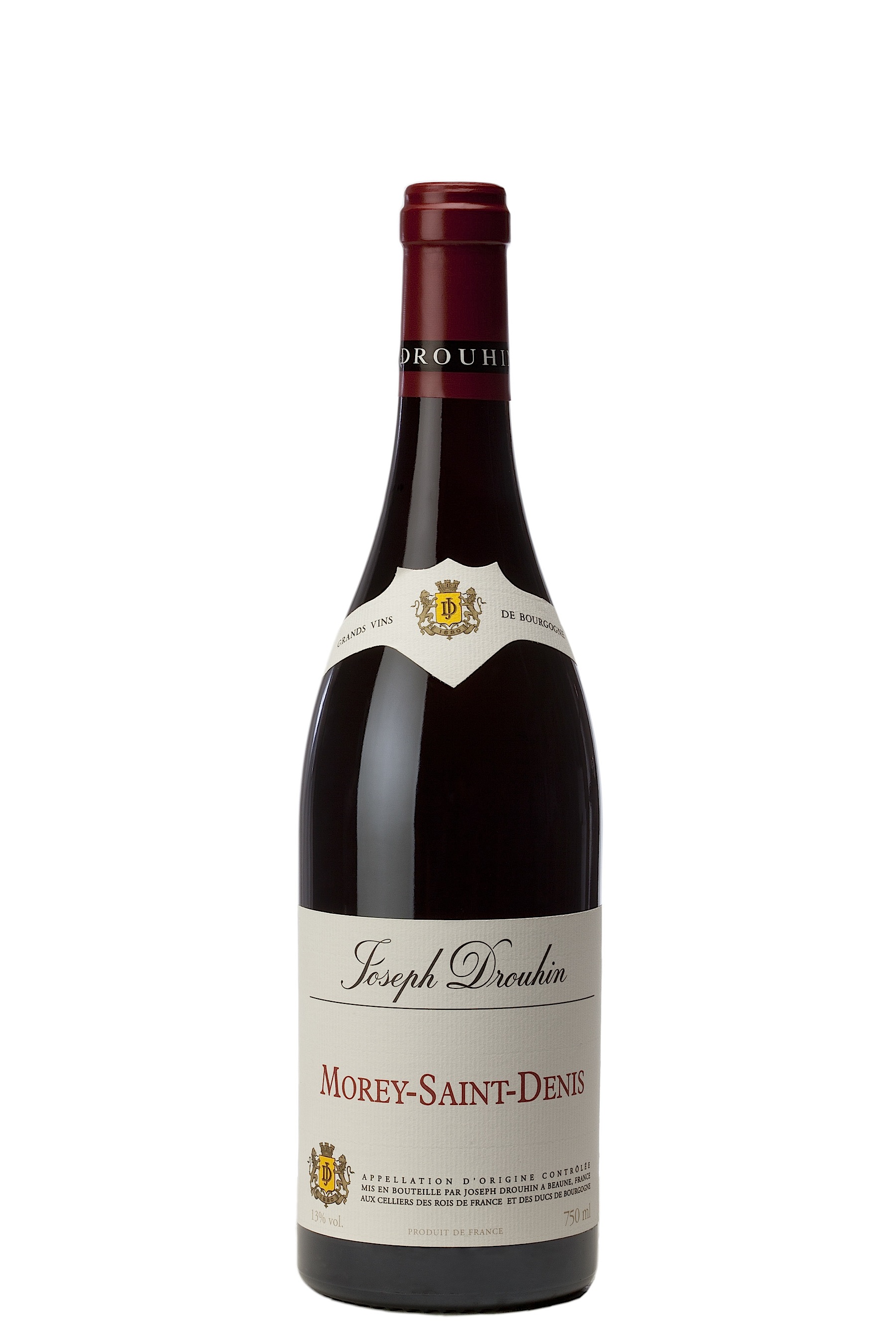 Chambolle-Musigny, and only garnered its own appellation in 1935. Relative to its more famous neighbors,
which have grand cru status, Morey-Saint-Denis wines are generally less
expensive than them yet express the same lush virtues of the best pinot
noir
grapes. Again, Drouhin draws from its partner vineyards with very low
yields in
order to “reveal every nuance of the terroir,” as well as deep color
and
lilac-like bouquet.
Chambolle-Musigny, and only garnered its own appellation in 1935. Relative to its more famous neighbors,
which have grand cru status, Morey-Saint-Denis wines are generally less
expensive than them yet express the same lush virtues of the best pinot
noir
grapes. Again, Drouhin draws from its partner vineyards with very low
yields in
order to “reveal every nuance of the terroir,” as well as deep color
and
lilac-like bouquet.
Using 20 percent new oak, Drouhin’s bottling spends 14 to 18 months in barrel, blended after extensive tastings of each one. I might well let the wine age a year or more, but at this point, on a summer’s night, it could not have been a better expression of great but affordable pinot noir.
Drouhin is also a fine representative of French vineyards’ 21st century attention to biological and biodynamic principles of cultivation to limit the amount of chemicals in the vineyards, using instead natural predators to control spiders and compost from organic matter instead of fertilizers. Under CEO Frederic Drouhin, the 131-year-old company, with 73 hectares (182.5 acres) in Burgundy, has also switched to bottles that are ten percent lighter, thereby reducing their carbon footprint.
Those
are applaudable commitments, especially since global warming is making
it
increasingly more difficult to grow the finicky pinot noir grape. But
right
now, wines like these, in this price category, will set a bar for a
novice wine
drinker by which to judge fine chardonnay and pinot noir.
And for those already converted long
ago, we are reminded by such wines of what it was we loved about them
in the
first place.
John Mariani's wine column appears in Bloomberg Muse News, from which this story was adapted. Bloomberg News covers Culture from art, books, and theater to wine, travel, and food on a daily basis.
Follow @VirtualGourmet
❖❖❖

The Riverside
Hotel
in
Evesham, England,
is
offering
a
complete
meal
for
customers'
dogs,
including
a choice of a soup, chicken-liver parfait, crêpes or home-made
fishcakes, rib-eye steak, salmon wellington, pizza or pan-fried chicken
supreme, carrot cake, rice pudding and chocolate biscuits. for 9.95
pounds ($16), served in china bowls on a silver platter, both in the
dining room or al fresco. “They really
seem to enjoy it, although their taste is a bit bland and you really
have to go
easy on the sugar and salt,” chef Rico Pech told Bloomberg News.
“The big dogs
will eat anything but the smaller ones are very picky, especially when
they’re
old."
 BLOCK THAT
METAPHOR!
BLOCK THAT
METAPHOR!
In
sports,
the
difference
between
being
a
superstar
and
just
an
average
player
is
consistency.
It's
the same thing in the restaurant business. Great
restaurants
dazzle every day, every table.We're not
saying Etna,
the cozy new
spot in Little Italy, is the Boobie Gibson of restaurants. More like
the Mo
Williams: very good, most of the time. Chef-owner Peppe Pilumeli's
simply
prepared Italian and Sicilian dishes are served in a warm atmosphere --
light-amber plastered walls, knickknack-cluttered windowsills and a
small,
inviting bar.--
Bob Migra, Cleveland Plain Dealer.
Any of John Mariani's books below
may be ordered from amazon.com.
" A fact-filled,
entertaining history [that] substantiates its title with hundreds of
facts in this meaty history of the rise of Italian food culture around
the
globe. From Charles Dickens's journey through Italy in 1844 to
20th-century
immigrants to America selling ice cream on the streets of New Orleans,
Mariani
constantly surprises the reader with little-known culinary anecdotes
about
Italy and its people, who have made pasta and pizza household dishes in
the
U.S. and beyond."--Publishers Weekly "Equal
parts
history,
sociology,
gastronomy,
and
just
plain
fun,
How
Italian
Food
Conquered
the
World
tells
the
captivating
and
delicious
story
of
the
(let's
face
it)
everybody's
favorite
cuisine
with
clarity,
verve
and
more
than
one
surprise."--Colman
Andrews,
editorial
director
of
The
Daily Meal.com. "A
fantastic and fascinating read, covering everything from the influence
of Venice's spice trade to the impact of Italian immigrants in
America and the evolution of alta cucina. This book will serve as a
terrific resource to anyone interested in the real story of Italian
food."--Mary Ann Esposito, host of PBS-TV's Ciao Italia. "John
Mariani
has
written
the
definitive
history
of
how
Italians
won
their
way
into
our
hearts,
minds,
and
stomachs.
It's
a
story
of
pleasure
over
pomp
and
taste
over
technique."--Danny
Meyer,
owner
of
NYC
restaurants
Union
Square
Cafe,
Gotham
Bar
&
Grill,
The
Modern,
and
Maialino.
|
 |
 |
 |
 |
 |
 |
 |
 |
❖❖❖
 Everett
Potter's
Travel
Report:
Everett
Potter's
Travel
Report: 
 Eating
Las
Vegas is the new on-line site for Virtual Gourmet
contributor John
A. Curtas., who since 1995 has been commenting on the Las Vegas food
scene and reviewing restaurants for Nevada Public Radio. He is
also
the restaurant critic for KLAS TV, Channel 8 in Las Vegas, and his past
reviews can be accessed at KNPR.org.
Click
on
the
logo
below
to
go
directly
to
his
site.
Eating
Las
Vegas is the new on-line site for Virtual Gourmet
contributor John
A. Curtas., who since 1995 has been commenting on the Las Vegas food
scene and reviewing restaurants for Nevada Public Radio. He is
also
the restaurant critic for KLAS TV, Channel 8 in Las Vegas, and his past
reviews can be accessed at KNPR.org.
Click
on
the
logo
below
to
go
directly
to
his
site.

Tennis Resorts Online: A Critical Guide to the World's Best Tennis Resorts and Tennis Camps, published by ROGER COX, who has spent more than two decades writing about tennis travel, including a 17-year stretch for Tennis magazine. He has also written for Arthur Frommer's Budget Travel, New York Magazine, Travel & Leisure, Esquire, Money, USTA Magazine, Men's Journal, and The Robb Report. He has authored two books-The World's Best Tennis Vacations (Stephen Greene Press/Viking Penguin, 1990) and The Best Places to Stay in the Rockies (Houghton Mifflin, 1992 & 1994), and the Melbourne (Australia) chapter to the Wall Street Journal Business Guide to Cities of the Pacific Rim (Fodor's Travel Guides, 1991).

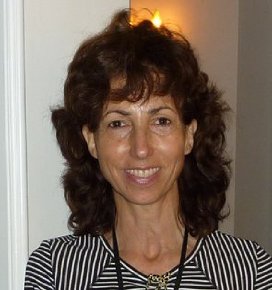
The Family Travel Forum
- A community for those who
"Have Kids, Still Travel" and want to make family vacations more fun,
less work and better value. FTF's travel and parenting features,
including
reviews of tropical and ski resorts, reunion destinations, attractions,
holiday
weekends, family festivals, cruises, and all kinds of vacation ideas
should be
the first port of call for family vacation planners. http://www.familytravelforum.com/index.html
ALL YOU NEED BEFORE YOU GO


MARIANI'S VIRTUAL GOURMET NEWSLETTER is published weekly. Editor/Publisher: John Mariani.
Contributing Writers: Christopher
Mariani, Robert Mariani,
John A. Curtas, Edward Brivio, Mort
Hochstein, and
Brian Freedman. Contributing
Photographers: Galina Stepanoff-Dargery, Bobby Pirillo. Technical
Advisor:
Gerry McLoughlin.
© copyright John Mariani 2011

